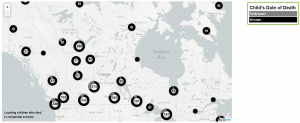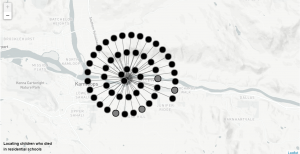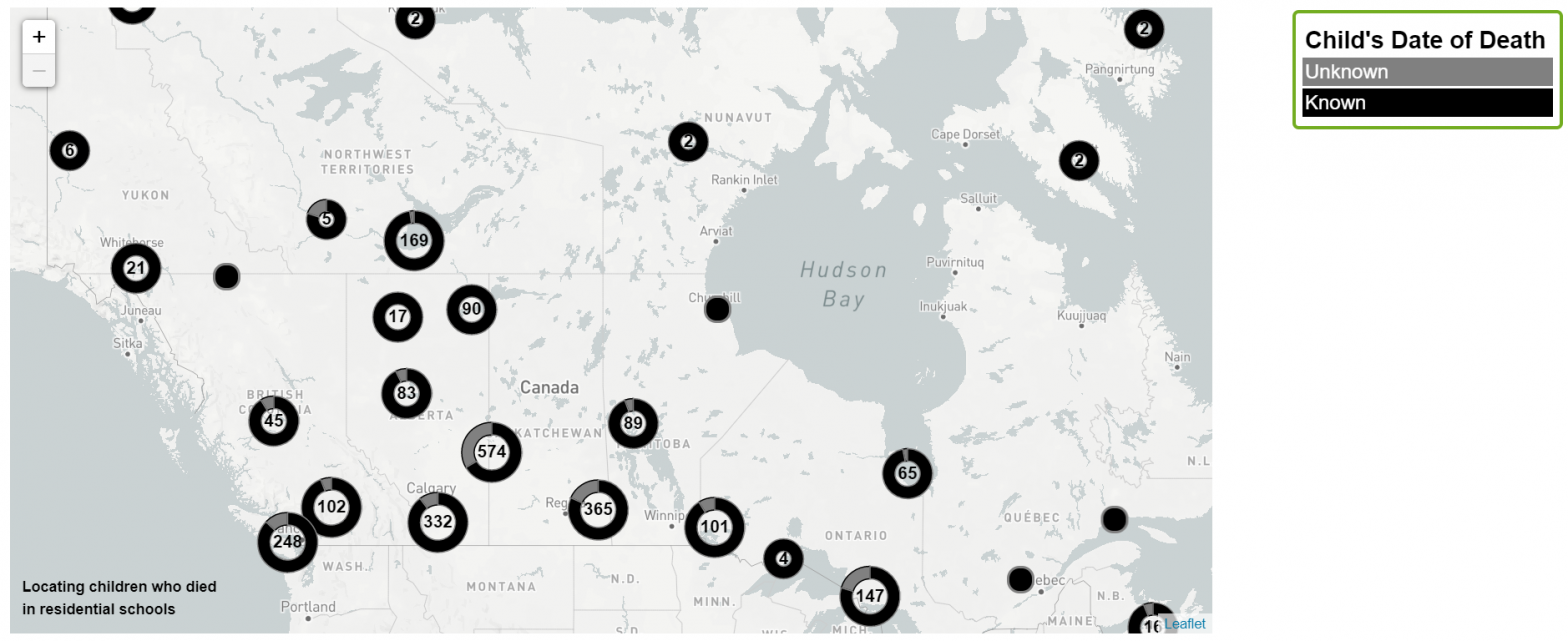Grim discovery
On Thursday, the Tk’emlúps te Secwépemc First Nation announced that a survey of the grounds at the former Kamloops Indian Residential School, in B.C.’s southern Interior, had uncovered the remains of 215 children. “To our knowledge, these missing children are undocumented deaths,” Tk’emlúps te Secwépemc Kukpi7 (Chief) Rosanne Casimir said in the statement. “Some were as young as three years old. We sought out a way to confirm that knowing out of deepest respect and love for those lost children and their families, understanding that Tk’emlúps te Secwépemc is the final resting place of these children.” Casimir says that the findings are “preliminary” and that a specialist’s report will be provided next month.
Several months ago, I summarized ongoing efforts to identify the several thousands of children who died in Indian Residential Schools, including the work of the Truth and Reconciliation Commission, the National Centre for Truth and Reconciliation (NCTR), and other groups and individuals.
I also prepared an interactive map, based on the NCTR’s Memorial Register of children who are known to have died in Indian Residential Schools, that I hope will help people see more clearly the destruction wrought by this system upon Indigenous children and their families.
Key findings of the TRCC
The “Missing Children and Unmarked Burials Project” of the Truth and Reconciliation Commission of Canada (TRCC) was the first systematic attempt to identify and analyze children’s deaths in Indian Residential Schools. Several of the TRCC’s key findings are relevant to this week’s discovery at the Kamploops IRS:
- The deaths of 3,200 children are identified in a Register of Confirmed Deaths of Named Residential School Students and the Register of Confirmed Deaths of Unnamed Residential School Students.
- The Canadian government is still withholding many documents that would assist in identifying hundreds and hundreds of other children who died in residential schools.
- The Canadian government often did not record the cause of death (49%), or even the name (32%) or gender (23%) of a child who died in a residential school.
- The Canadian government’s practice throughout much of this history was not to return the bodies of children who had died at school back home.
Interacting with the map

Before beginning, it’s critical to understand: The map does not represent all children who died in residential schools; their names and numbers will never be known. With that said, these tips may be helpful:
- A markercluster donut represents either:
- children known to have died at a single residential school, or
- children known to have died at one of a group of residential schools located in that vicinity.
- The number in a donut’s centre represents the number of children known to have died there.
- The black segment around the donut represents the proportion of children whose dates of death are known, at least approxately. The gray segment represents the proportion of children whose dates of death are unknown.
- Hovering your mouse over a black/gray segment will reveal the number of children whose dates of death are known/unknown.
- Clicking your mouse on a donut that represents a group of residential schools will reveal the group’s members.
- Clicking on a donut that represents a single residential school will reveal a set of black and/or gray dots representing individual children who are known to have died there.
- Clicking on a single dot will display basic information about an individual child and the residential school where she or he died.
Kamloops before … and after?
Before the Tk’emlúps te Secwépemc First Nation announced on Thursday the discovery of the remains of 215 children on the grounds of the former Kamloops Indian Residential School, 51 children were already known to have died there:

As the children’s remains are identified, the picture of Kamloops’ residential school will become even more devastating.
Chief Casimir says community members are still “grappling” with the shock of the news as leadership looks at what steps to take next. They are working with the BC Coroners Service, contacting the students’ home communities, protecting the remains and working with museums to find records of these deaths.
In a statement to CBC, Lisa Lapointe, B.C.’s chief coroner, said the Coroners Service was alerted to the discovery on Thursday. “We are early in the process of gathering information and will continue to work collaboratively with the Tk’emlúps te Secwépemc and others as this sensitive work progresses,” Lapointe said. “We recognize the tragic, heartbreaking devastation that the Canadian residential school system has inflicted upon so many, and our thoughts are with all of those who are in mourning today.”
Credits

This work, including the interactive map, is licensed under a Creative Commons Attribution 4.0 International License. If you use this work, please credit Paul Allen, paul@hartallen.com.
